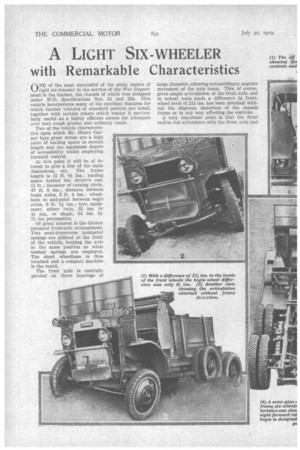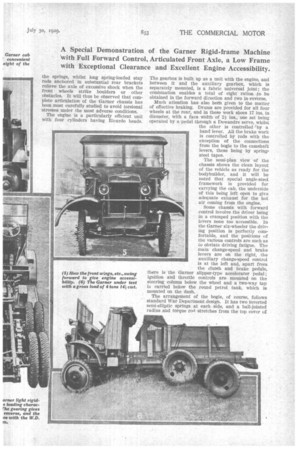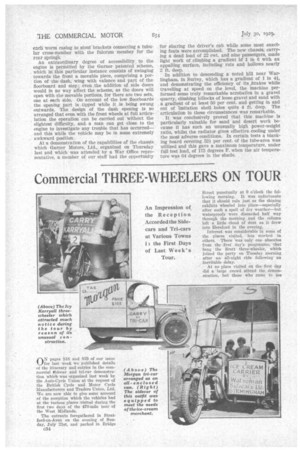A LIGHT SIX-WHEELER (I) The off with Remarkable Characteristics showing the
Page 54

Page 55

Page 56

If you've noticed an error in this article please click here to report it so we can fix it.
controls and
A Special Demonstration of the Garner Rigid-frame Machine With Full Forward Control, Articulated Front Axle, a Low Frame with Exceptional Clearance and Excellent Engine Accessibility.
ONE of the most successful of the many makes of rigid six-wheeler in the service of the War Department is the Garner, the chassis of which was designed under W.D. Specifications Nos. 31 and 23a. This vehicle incorporates many of the excellent features for which Garner vehicles of standard pattern are noted, together with certain others which render it particularly useful as a highly efficient means for transport over both rough ground and ordinary roads.
Two of the vehicle characteristics upon which Mr. Henry Garner lays great stress are a high ratio of loading space to overall length and the maximum degree of accessibility whilst employing forward control.
At this point it will be of interest to give a few of the main dimensions, etc. The frame length is 15 ft. 61 ins.; loading space behind the driver's cab, 11 ft. ; diameter of turning circle, 47 ft. 6 ins.; distance between bogie axles, 3 ft. 4 ins.; wheelbase to mid-point between bogie axles, 9 ft. 71 ins.; tyre equipment, either twin, 32 ins, by ins., or single, 34 ins. by 71 ins. pneumatics.
Of great interest is the Garner patented front-axle arrangement. Two semi-transverse laminated springs are utilized at the front of the vehicle, keeping the axle in the same position as when normal springs are employed. The short wheelbase is thus retained and a compact machine Is the result.
The front axle is centrally pivoted on three bearings of large diameter, allowing -extraordinary angular movement of the axle beam. This, of course, gives ample articulation of the front axle, and in actual tests made a difference in frontwheel level of 211 ins, has been obtained without the slightest distortion of the chassis frame or in any way affecting the controls.
A very important point is that the front radius rod articulates with the front axle and the springs, whilst long spring-loaded stay rods anchored in substantial rear brackets relieve the axle of excessive shock when the front wheels strike boulders or other obstacles. It will thus he observed that complete articulation of the Garner chassis has been most carefully studied to avoid torsional stresses under the most adverse conditions.
The engine is a particularly efficient unit with four cylinders having Ricardo heads. The gearbox is built up as a unit with the engine, and between it and the auxiliary gearbox, which is separately mounted, is a fabric universal joint ; the combination enables a total of eight ratios, :to be obtained in the forward direction and two in-reverse.
Much attention has also been given to the matter of effective braking. Drums are provided for an four wheels at the rear, and in these work shoes 17 ins, in diameter, with a face width of 2 ins., one set being operated by a pedal through a Dewandre servo, whilst the other is controlled 13y a hand lever. All the brake work is controlled by rods with the exception of the connections from the bogie to the camshaft levers, these being by springsteel tapes.
The semi-plan view of the chassis shows the clean layout of the vehicle as ready for the bodybuilder, and it will be noted that special angle-steel framework is provided for carrying the cab, the underside of this being left open to give adequate exhaust for the hot air coming from the engine.
Some chassis with forward control involve the driver being in a cramped position with the levers none too accessible. In the Garner six-wheeler the driving position is perfectly comfortable, and the positions Of the various controls are such as to obviate driving fatigue. The main change-speed and brake levers are on the right, the auxiliary change-speed control is at the left and, apart from the clutch and brake pedals, there is the Garner slipper-type accelerator pedal ; ignition and throttle controls are mounted on the steering column below the wheel and a two-way tap is carried below the round petrol tank, which is mounted on the dash.
The arrangement of the bogie, of course, follows standard War Department design. It has two inverted semi-elliptic springs at each side, and a ball-jointed radius and torque rod stretches from the top cover of each worm casing to stout brackets connecting a tubular cross-member with the fulcrum member for the rear spring's.
An extraordinary degree of accessibility to the engine is permitted by the Garner patented scheme, which in this particular instance consists of swinging towards the front a movable piece, comprising a portion of the dash, wing with valance and part of the floorboard and step; even the addition of side doors would in no way affect the scheme, as the doors will open with the movable portions, for there are two sets, one at each side. On account of the low floorboards the opening part is tipped while it is being swung outwards. The design of the dash opening is so arranged that even with the front wheels at full articulation the operation can be carried out without the slightest difficulty, and a man can get close to the engine to investigate any trouble that has occurred— and this while the vehicle may be in some extremely awkward position.
At a demonstration of the capabilities of the chassis which Garner Motors, Ltd., organized on Thursday last and which was attended by a War Office representative, a member of our staff had the opportunity
for sharing the driver's cab while some most exacting feats were accomplished. The new chassii, carrying a dead load of 22 cwt. and nine passengers, made light work of climbing a gradient of 1 in 6 with an appalling surface, including ruts and hollows nearly 2 ft. deep.
In addition to descending a noted bill near Warlingham, in Surrey, which has a gradient of 1 in 41, and demonstrating the efficiency of its .brakes while travelling at speed on the level, the machine performed some truly remarkable acrobatics in a gravel quarry, climbing hillocks of loose gravel and sand with a gradient of at least 50 per cent. and getting in and out of Imitation shell holes quite 4 ft. deep. The articulation in these circumstances was remarkable.
It was conclusively proved that this machine is particularly valuable for sand and desert work because it has such an unusually high power-weight ratio, whilst the radiator gives effective cooling under the most adverse conditions. In certain tests a blanking board covering 521 per cent. of the tube-area was utilized and this gave a maximum temperature, under full test load, of 175 degrees F. when the air temperature was 64 degrees in the shade.












































































































